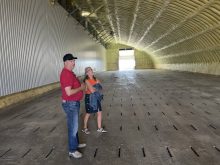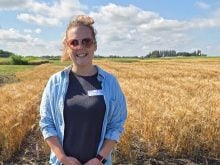Identifying the different genotypes will help growers select the right fungicide
Traps designed to identify potato blight spores could help potato growers prevent infection of their crops.
Researcher and Lethbridge College instructor Melanie Kalischuk is in the second year of a three-year project to erect a network of volumetric traps that will help her and her students identify the presence of late blight spores.
The information can then be shared with growers and processors through Potato Growers of Alberta channels.
“This way we can kind of pinpoint fungicide applications and perhaps apply the fungicides in a proactive manner, before the pathogen actually affects the crop,” said Kalischuk.
Read Also

VIDEO: Agritechnica Day 4: Robots and more robots, Nexat loves Canada and the trouble with tariffs
Agritechnica Day 4: Robots and more robots, Nexat loves Canada and the trouble with tariffs.
“Often when growers identify that they have late blight in the field, they start applying the fungicides. This way they can actually apply the fungicides in a proactive manner.”
Most of the traps are in the Taber and Vauxhall regions, where most commercial potatoes are grown. There are also traps in the seed potato growing areas around Lacombe and Edmonton.
Kalischuk recently received $191,000 from the PGA, the Alberta Crop Industry Development Fund, Lethbridge College and the college’s Tiffin endowment fund to continue the project.
She said the funding will allow her to increase the number of students involved in the project. They help set up and monitor the traps and identify the pathogens found in the traps.
Kalischuk said it is possible to eliminate late blight from Alberta, which was once designated as blight free. The infection was detected in 2012 and has made periodic appearances since then when conditions favor its development.
There are different genotypes of late blight, and some strains respond differently to fungicides, said Kalischuk. Identifying the genotypes will help growers select the right management tool or fungicide when spores are detected.
Late blight, formally called Phytophthora infestans, is the blight that caused the infamous Irish potato famine. It can also infect tomatoes.
















